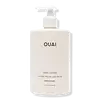What's inside
What's inside
 Key Ingredients
Key Ingredients

No key ingredients
 Benefits
Benefits

 Concerns
Concerns

 Ingredients Side-by-side
Ingredients Side-by-side

Water
Skin ConditioningCamellia Oleifera Seed Oil
Skin ConditioningVitis Vinifera Seed Oil
EmollientCetyl Alcohol
EmollientGlycerin
HumectantGlyceryl Stearate
EmollientAloe Barbadensis Extract
Skin ConditioningCitrus Aurantium Dulcis Peel Oil
MaskingCitrus Reticulata Peel Oil
MaskingTocopherol
AntioxidantHippophae Rhamnoides Fruit Oil
Skin ProtectingRosa Canina Fruit Oil
EmollientTriticum Vulgare Germ Oil
EmollientVanillin
MaskingXanthan Gum
EmulsifyingSodium Stearoyl Glutamate
CleansingRosa Damascena Flower Oil
MaskingSodium Phytate
Benzyl Alcohol
PerfumingDehydroacetic Acid
PreservativeLinalool
PerfumingLimonene
PerfumingWater, Camellia Oleifera Seed Oil, Vitis Vinifera Seed Oil, Cetyl Alcohol, Glycerin, Glyceryl Stearate, Aloe Barbadensis Extract, Citrus Aurantium Dulcis Peel Oil, Citrus Reticulata Peel Oil, Tocopherol, Hippophae Rhamnoides Fruit Oil, Rosa Canina Fruit Oil, Triticum Vulgare Germ Oil, Vanillin, Xanthan Gum, Sodium Stearoyl Glutamate, Rosa Damascena Flower Oil, Sodium Phytate, Benzyl Alcohol, Dehydroacetic Acid, Linalool, Limonene
Water
Skin ConditioningIsopropyl Palmitate
EmollientCaprylic/Capric Triglyceride
MaskingCetyl Alcohol
EmollientStearic Acid
CleansingPersea Gratissima Oil
Skin ConditioningRosa Canina Fruit Oil
EmollientSimmondsia Chinensis Seed Oil
EmollientLecithin
EmollientSodium Acrylates Copolymer
Glyceryl Stearate
EmollientPEG-100 Stearate
Acrylates/C10-30 Alkyl Acrylate Crosspolymer
Emulsion StabilisingDisodium EDTA
Aminomethyl Propanol
BufferingChlorphenesin
AntimicrobialPhenoxyethanol
PreservativeParfum
MaskingCitronellol
PerfumingLimonene
PerfumingHydroxycitronellal
PerfumingLinalool
PerfumingCitral
PerfumingWater, Isopropyl Palmitate, Caprylic/Capric Triglyceride, Cetyl Alcohol, Stearic Acid, Persea Gratissima Oil, Rosa Canina Fruit Oil, Simmondsia Chinensis Seed Oil, Lecithin, Sodium Acrylates Copolymer, Glyceryl Stearate, PEG-100 Stearate, Acrylates/C10-30 Alkyl Acrylate Crosspolymer, Disodium EDTA, Aminomethyl Propanol, Chlorphenesin, Phenoxyethanol, Parfum, Citronellol, Limonene, Hydroxycitronellal, Linalool, Citral
 Reviews
Reviews

Ingredients Explained
These ingredients are found in both products.
Ingredients higher up in an ingredient list are typically present in a larger amount.
Cetyl Alcohol is a fatty alcohol. Fatty Alcohols are most often used as an emollient or to thicken a product.
Its main roles are:
Though it has "alcohol" in the name, it is not related to denatured alcohol or ethyl alcohol.
The FDA allows products labeled "alcohol-free" to have fatty alcohols.
Learn more about Cetyl AlcoholGlyceryl Stearate is a mix of glycerin and stearic acid.
It is used to stabilize the mixing of water and oil ingredients. By preventing these ingredients from separating, it can help elongate shelf life. It can also help thicken the product's texture.
As an emollient, it helps soften skin and supports barrier-replenishing ingredients.
In cosmetics, Glyceryl Stearate is often made from vegetable oils or synthetically produced.
This ingredient may not be fungal-acne safe
Fun fact: The human body also creates Glyceryl Stearate naturally.
Learn more about Glyceryl StearateLimonene is a fragrance that adds scent and taste to a formulation.
It's found in the peel oil of citrus fruits and other plants such as lavender and eucalyptus. The scent of limonene is generally described as "sweet citrus".
Limonene acts as an antioxidant, meaning it helps neutralize free radicals.
When exposed to air, oxidized limonene may sensitize the skin. Because of this, limonene is often avoided by people with sensitive skin.
The term 'fragrance' is not regulated in many countries. In many cases, it is up to the brand to define this term. For instance, many brands choose to label themselves as "fragrance-free" because they are not using synthetic fragrances. However, their products may still contain ingredients such as essential oils that are considered a fragrance.
Learn more about LimoneneLinalool is a fragrance and helps add scent to products. It's derived from common plants such as cinnamon, mint, citrus, and lavender.
Like Limonene, this ingredient oxidizes when exposed to air. Oxidized linalool can cause allergies and skin sensitivity.
This ingredient has a scent that is floral, spicy tropical, and citrus-like.
Learn more about LinaloolRosehip Oil is a non-fragrant plant oil. Rosehips are a fruit from a rose bush and are edible. This oil has skin conditioning and hydrating properties.
Rosehip contains Vitamin C, Vitamin E, fatty acids and linolenic acids. These nourish your skin barrier. Having hydrated skin may help reduce the appearance of fine-lines and wrinkles.
Another great component of Rosehip Oil is Vitamin A, or retinol. Vitamin A encourages your skin to create more collagen.
Rosehip oil may help with reducing pigmentation. The lycopene and beta-carotene have skin-lightening properties. However, more studies are needed to confirm this.
Learn more about Rosa Canina Fruit OilWater. It's the most common cosmetic ingredient of all. You'll usually see it at the top of ingredient lists, meaning that it makes up the largest part of the product.
So why is it so popular? Water most often acts as a solvent - this means that it helps dissolve other ingredients into the formulation.
You'll also recognize water as that liquid we all need to stay alive. If you see this, drink a glass of water. Stay hydrated!
Learn more about Water